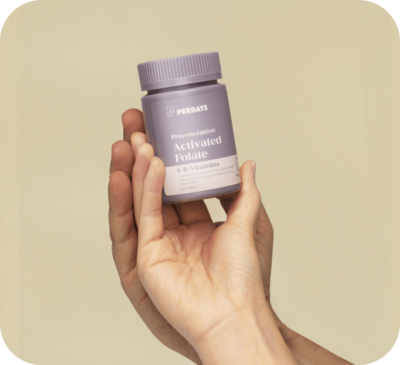The Essentials
- Folate is crucial for women during conception and in the first trimester
- 2022 research shows less than 1% of pregnant women get enough folate through diet alone
- Folic acid is the synthetic form of folate
- Approximately 1/3 of women cannot absorb folic acid due to a genetic variation in the MTHFR gene (or other nutritional deficiencies)
- To determine your body’s ability to utilise folic acid, organise an MTHFR test through your doctor or health practitioner (e.g. naturopath)
- If cannot utilise Folic Acid, choose a prenatal folate supplement that contains active folate or folinic acid
- Supplementing your diet with folate before and during pregnancy helps reduce the risk of neural tube defects such as spina bifida
Should I take Folic Acid For Pregnancy?
What is Folate?
Folate is vitamin B9. It is a water-soluble vitamin primarily found in green leafy vegetables such as spinach, broccoli, asparagus, and kale, as well as legumes and beans and some fruits like strawberries & oranges. Folate is what this nutrient is referred to when it occurs naturally in these foods.
However, the terms folate and folic acid are used interchangeably in processed foods, so it’s important to choose active forms (from food sources or quality supplements) to optimise absorption.
During pregnancy, folate plays a vital role in the development of the baby’s neural tube, which eventually becomes the brain and spinal cord. Adequate folate intake during the early stages of pregnancy can significantly reduce the risk of neural tube defects, such as spina bifida and anencephaly.
What is the difference between folic acid and folate?
While folate is the naturally occurring form, folic acid is synthetic. Folic acid is of no use to the body until it is converted to an active form, which requires enzymatic activity and is relatively slow.
This is the kind of folate found in many conventional prenatal supplements as well as what is added to our non-organic wheat bread flour.
This is a safe and effective government health policy to help reduce folate deficiencies in women and therefore reduce the probability of spina bifida and other neural tube defects.
The problem is in the Australian processed food industry, synthetic folic acid can be labeled as folate or folic acid. This means it can be challenging to know what your folate or folic acid intake really is.
Does Your Prenatal Contain Folic Acid or Active Folate?
Another issue is folic acid is very cheap. This means it is commonly used in conventional prenatal supplements. And unfortunately, these products rarely warn that one-third of women may not able to fully absorb folic acid – potentially leaving them at risk of deficiency.
All this means many women may not be getting the form of folate their bodies can actually metabolise.
Folic Acid, Folate and the MTHFR Gene
MTHFR might seem like yet another complex acronym to add to your already extensive pregnancy-related vocabulary.
MTHFR stands for Methylene-Tetrahydrofolate Reductase, an enzyme that plays a crucial role in folate metabolism – transforming synthetic folic acid into its activated (methylated) form, known as 5-methyltetrahydrofolate (5-MTHF).
While most women produce enough of the enzyme to convert folic acid into active folate, around 1/3 do not.
Depending on which of the 34 MTHFR genetic variants you have (and there are only two you can be tested for) and whether one or two copies are present, your enzyme function may be reduced by 10-70% (Ref).
So, your body may be able to effectively use synthetic folic acid – or it might not.
When should I start taking folic acid for pregnancy? (Or ideally an active form of folate)
Generally speaking, at a minimum, it is recommended that women trying to conceive take a folic acid supplement (or active folate) at least 1 month before and 3 months after conception.
Ideally, you should start taking prenatal folate 3 months prior to conception, to ensure good levels of this important nutrient. This is especially important since you cannot predict exactly when conception will happen.
How much folic acid should I take while pregnant?
The answer is – it depends.
For most women, the recommended daily folate intake is 400mcg. This is achievable with a well-balanced diet. Unfortunately, many women struggle to do this. Recent data shows the average daily folic acid intake for Australian women is closer to 250mcg.
So, not only is there a good chance you are not getting enough folate now, you will need sufficiently more during conception and your first trimester to reach the recommended 600 mcg daily intake.
A good option is to take use a folate supplement to ensure you are reaching your daily target. By using a prenatal with active folate, you know you’ll be getting the folate you need – regardless of your genetics.
What prenatal vitamins contain folate?
Generally, you need to choose a prenatal containing 400-500 mcg of activated folate. This way you know you are receiving enough daily folate for pregnancy in a form that is easy to metabolise – regardless of your genetics or potential enzyme deficiencies.
The names for these vary, so here is a list:
- Folinic acid
- Levomefolate calcium
- Methylated Folate
- 5-L-MTHF (or 5-L-methyltetrahydrofolate)
- Calcium folinate
Our folate prenatal contains 500mcg of biologically activated folate as Quatrefolic®.
Looking for a folate prenatal that all women can absorb?
Perdays Preconception Activated Folate with B Vitamins is specially formulated for mums who prefer or require activated folate to support their preconception and pregnancy health.
References
- https://www.healthdirect.gov.au/folate
- https://www.foodstandards.gov.au/publications/Documents/Folic%20Acid%20Fortification%20Monitoring%20Report.pdf
- https://www.nrv.gov.au/nutrients/folate
- https://www.pregnancybirthbaby.org.au/folate-and-pregnancy
- https://www.racgp.org.au/afp/2016/april/mthfr-genetic-testing-controversy-and-clinical-imp

